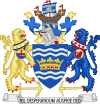
Back Sundrodland ANG شهر ساندرلند AZB Sunderland Breton Sunderland (kondado) CEB Dinas Sunderland Welsh City of Sunderland German شهر ساندرلند Persian Cité de Sunderland French City of Sunderland FRR Città di Sunderland Italian
City of Sunderland | |
|---|---|
| Sunderland | |
 Sunderland White Lighthouse | |
 Sunderland shown within Tyne and Wear | |
| Coordinates: 54°54′36″N 1°23′06″W / 54.910°N 1.385°W | |
| Sovereign state | United Kingdom |
| Country | England |
| Region | North East |
| Combined Authority | North East |
| Ceremonial county | Tyne and Wear |
| Historic county | Durham |
| Established as Sunderland Metropolitan Borough | 1 April 1974 |
| City status | 20 May 1992 |
| Admin HQ | Sunderland |
| Government | |
| • Type | Leader and Cabinet |
| • Body | Sunderland City Council |
| • MPs | Bridget Phillipson (L) Sharon Hodgson (L) Julie Elliott (L) |
| Area | |
| • Land | 53 sq mi (137 km2) |
| Population | 277,354 (Ranked 60th) |
| • Density | 5,190/sq mi (2,003/km2) |
| Ethnicity (2021) | |
| • Ethnic groups | |
| Religion (2021) | |
| • Religion | List
|
| Time zone | UTC+0 (Greenwich Mean Time) |
| • Summer (DST) | UTC+1 (British Summer Time) |
| Postcode areas | |
| Dialling code | 0191 |
| Website | www |
Sunderland (/ˈsʌndərlənd/),[2] also known as the City of Sunderland, is a metropolitan borough with city status in the metropolitan county of Tyne and Wear, England. It is named after its largest settlement, Sunderland, spanning a far larger area, including nearby towns including Washington, Hetton-le-Hole and Houghton-le-Spring, as well as the surrounding villages and hamlets. The district also forms a large majority of Wearside which includes Chester-le-Street in County Durham.
The district was formed in 1974 as part of the provisions of the Local Government Act 1972 and is an amalgamation of four former local government districts of County Durham. It was granted city status in 1992, the Ruby Jubilee of Queen Elizabeth II's accession to the throne. The borough had a population of 575,400 at the time of the 2011 census, with the majority of the population (274,286) residing in Sunderland, making it the largest settlement in the north east of England.[3]
- ^ a b UK Census (2021). "2021 Census Area Profile – Sunderland Local Authority (E08000024)". Nomis. Office for National Statistics. Retrieved 5 January 2024.
- ^ "Local Authority Districts, Counties and Unitary Authorities (April 2021) Map in United Kingdom". Office for National Statistics: Open Geography Portal. Retrieved 1 August 2023.
- ^ "2011 Census – Built-up areas". ONS. Archived from the original on 21 September 2013. Retrieved 6 August 2013.
